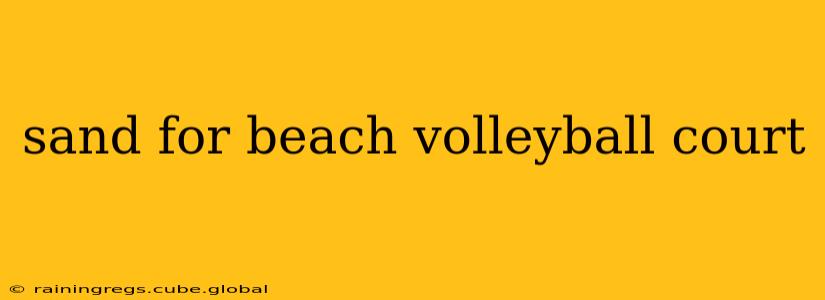Beach volleyball is a thrilling sport, but the foundation of a great game lies in the quality of the sand. Choosing the right sand significantly impacts gameplay, player safety, and the overall experience. This comprehensive guide delves into the specifics of sand selection for beach volleyball courts, ensuring you build or maintain a court that's perfect for competition or casual play.
What Kind of Sand is Best for Beach Volleyball?
The ideal sand for a beach volleyball court is a well-graded, medium-sized silica sand. This type of sand offers the perfect balance of firmness, drainage, and player comfort. Avoid fine sands which can become too compact and hard, increasing the risk of injury. Conversely, coarse sands can be too loose, making consistent play difficult. The goal is to find a sand that provides excellent traction while allowing for smooth ball movement. Specific particle size recommendations often fall within a range, typically between 0.25mm and 0.7mm, with the average around 0.5mm.
How Much Sand Do I Need for a Beach Volleyball Court?
The amount of sand needed varies based on the court dimensions and the desired depth. A standard beach volleyball court measures 16 meters by 8 meters. The depth should typically be between 40cm and 50cm. Therefore, a rough calculation involves multiplying the surface area (128 square meters) by the depth (0.4-0.5 meters) to obtain the cubic volume. Remember that this is just a starting point, and you may need to adjust based on the specific sand's compaction characteristics. It's often advisable to purchase slightly more sand than calculated to account for settling and potential loss during installation.
What is the Best Depth for Beach Volleyball Sand?
The ideal depth of sand for a beach volleyball court balances player comfort and performance. A depth of 40-50cm generally offers excellent shock absorption, reducing the impact on joints, while still providing sufficient traction for players. Shallower sand might result in increased stress on players' bodies, leading to a higher risk of injuries. Conversely, excessively deep sand will slow down the game and make it difficult to control the ball.
What are the Different Types of Sand Used for Volleyball Courts?
While silica sand is the most commonly used and preferred option, other types of sand are available. However, these may not offer the same playing characteristics or safety profile. Some builders might use a mix of sands to achieve desired characteristics but careful consideration of the mix ratio is critical. Before using any sand other than silica, research its suitability for beach volleyball carefully.
How Do I Test My Beach Volleyball Sand?
Regular testing is essential to maintain the ideal playing conditions. You can perform simple tests to assess the sand’s drainage, compaction, and particle size distribution. Pay attention to how quickly water drains after rainfall or watering. Also, examine the consistency of the sand by digging into the court and observing how well it holds its form. If the sand is too compact or too loose, adjustments may be needed. Lab analysis is also an option to obtain precise measurement of sand grain size.
What is the Cost of Sand for a Beach Volleyball Court?
The cost varies widely depending on location, supplier, sand quality, and the amount required. It's best to obtain quotes from multiple suppliers to compare prices. Keep in mind that the initial investment in high-quality sand is an investment in a long-lasting and safe playing surface. Consider the cost of transportation and installation in addition to the sand itself.
Can I Use Playground Sand for a Beach Volleyball Court?
While playground sand might seem like a cost-effective option, it's generally not recommended. Playground sand often contains finer particles that can compact too easily, leading to a hard playing surface that increases the risk of injury. The desired playing characteristics are different between a playground sand and one for beach volleyball.
This guide provides a solid foundation for selecting and managing the sand for your beach volleyball court. Remember that a well-maintained court contributes significantly to player safety and enjoyment. Using the right sand is the first crucial step in ensuring an excellent playing experience.
